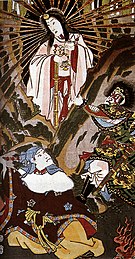User:Immanuelle/Takehazuchi
| This user page or section is currently being expanded by an editor. You are welcome to help in expanding too. If this page has not been changed in several days, please remove this template. This page was last edited by Immanuelle (talk | contribs) 23 hours ago. |
| This is a draft being worked on by Immanuelle. It is too complex at the moment but she wants to get it ready to be an article someday. Others are free to edit it This page was last edited by Immanuelle (talk | contribs) 23 hours ago. |
| The English used in this user page may not be easy for everybody to understand. You can help Wikipedia by reading Wikipedia:How to write Simple English pages, then simplifying the page. |
| Takehazuchi | |
|---|---|
 Inasa Beach (稲佐の浜 Inasa-no-hama) in Izumo, Shimane, Shimane Prefecture, where the myth places Ōkuninushi's meeting with the messengers of heaven and his surrender to them. | |
| Other names | Ama no Hazuchi |
| Major cult centre | Shitori Shrine Katsuraki Shitori ni Imasu Ame no Ha Ikazuchi no Mikoto Shrine |
Takehazuchi (天羽槌雄神)[a] is the Japanese god of weaving[1] Also known as Shizuri.[2]
He is a warrior who vanquished the rebellious star god Amatsu-Mikaboshi during the Tenson kōrin.[3][1][2]
Appended to the two passages of the subjugation of the earth in the Nihon Shoki and the Kojiki is the mention of a star deity named Amatsu-Mikaboshi who resisted till the end, and whom Takemikazuchi and Futsunushi were particularly eager to vanquish. The latter passage states that the being who subdued the star god, referred to as Iwai no nushi (斎の大人) is enshrined at Katori, hinting that it might be Futsunushi.[4][1] However, the earlier passage says a god named Takehazuchi was the vanquisher of the star god.[3][5]
After Ōkuninushi's assent and withdrawal, the two messengers proceeded to destroy everyone and everything who refused to submit to their authority. They then send the god of weaving, Takehazuchi (建葉槌), to subdue the star god Kagaseo (香香背男), the last remaining rebel against Takamagahara (Nihon Shoki).[1] After the resistance was gone the Tenson kōrin could begin.[2]
The Kogo Shūi identifies him with Amenohatsuchio the ancestor of the Shizuri clan who did weaving.[2]
At Shitori Shrine Takehazuchi and Shitateruhime-no-Mikoto are worshipped as weaving gods[2].
Shrines[change | change source]
Takehazuchi is believed to be the ancestor of the Shitori clan (倭文氏) of Shitori Shrine[6].[2]
However, the legends of Shitori Shrine are all centered around Shitateruhime-no-Mikoto, whom the shrine legend claims arrived in this location from Izumo by boat. She established her residence on the mountain behind this shrine, and after her death, she was buried in a kofun constructed in the shrine's precincts.[6]
See Also[change | change source]
Notes[change | change source]
- ↑ also read as Amenohazuchi
References[change | change source]
- ↑ 1.0 1.1 1.2 1.3 Aston (1896). "
 Book II".
Book II".  Nihongi: Chronicles of Japan from the Earliest Times to A.D. 697. Wikisource. pp. 69–70.
Nihongi: Chronicles of Japan from the Earliest Times to A.D. 697. Wikisource. pp. 69–70.
- ↑ 2.0 2.1 2.2 2.3 2.4 2.5 Mizue, Mori. "Shizuri". Kokugakuin University Encyclopedia of Shinto.
- ↑ 3.0 3.1 宇治谷 1988 『日本書紀』上 p.64, 58
- ↑ 寺島良安; 島田勇雄, 樋口元巳 (1985). 和漢三才図会. Vol. 10. 平凡社. p. 71. ISBN 9784582804478. subscribes to this view
- ↑ "Hoshinokamikakaseo | 國學院大學デジタルミュージアム". web.archive.org. 2024-03-20. Retrieved 2024-03-20.
- ↑ 6.0 6.1 Yoshiki, Emi (2007). Zenkoku 'Ichinomiya' tettei gaido (in Japanese). PHP Institute. ISBN 978-4569669304.
Bibliography[change | change source]
- Chamberlain, Basil Hall (1919) [1882]. A Translation of the "Ko-ji-ki," or a record of ancient matters. Transactions of the Asiatic Society of Japan. Vol. X.
- 武田, 祐吉 (Yūkichi Takeda) (1996) [1977]. 中村啓信 (ed.). 新訂古事記. 講談社. pp. 60, 62, 77, 78, 95. ISBN 4-04-400101-4.
- Aston, William George (1896). Nihongi: Chronicles of Japan from the Earliest Times to A.D. 697. Vol. 1. London: Japan Society of London. ISBN 9780524053478., English translation
- 宇治谷, 孟 (Tsutomu Ujitani) (1988). 日本書紀. Vol. 上. 講談社. ISBN 9780802150585.
 |
|
|
Mythic Texts and Folktales:
|
- Japanese gods
- Thunder gods
- War gods
- Earthquake myths
- Amatsukami
- Interlanguage link template existing link Categorty:Japan
- Japan
- Interlanguage link template existing link
- Weaving
- Interlanguage link template existing link
- Gods of Japan
- Gods and goddesses of Japan
- Amatsukami
- Draft articles simple:User:Immanuelle/Immanuelle/Takehazuchi
- Wikipedia drafts
- Textiles in folklore
